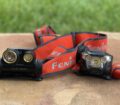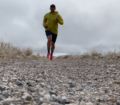I recently attended a seminar in foam rolling and stretching. The speaker was Robert Pavletic, a personal trainer and author of “America’s Field Guide To Fitness”. One of the most useful demonstrations I learned involved the proper technique for foam rolling and Self Myo-Fascial Release. Robert is not an ultrarunner but he is a fitness professional with over 25 years of experience in training the body for peak performance. Robert’s presentation on stretching and foam rolling was so informative, I asked him for an interview for Trail and Ultra. I believe his suggestions and advice are on-point for those of us in the sport of ultra-distance running.
(Robert) This is a great question. Runners, especially, are prone to over use injuries. The repetitive nature of the sport puts significant stress on the joints and muscles. There are a couple of things to look for that can greatly reduce the risk of injury.
1. Mechanics: Very few people, including elite athletes, walk with proper mechanics, let alone run with proper mechanics. Feet should always be pointing straight ahead. Often, the foot externally rotates when pushing off and that causes not only ankle stress, but muscle imbalances in the calf muscles and the Peroneals on the outside of the lower leg. This mis-alignment causes the knee to “adduct” or move inward. That causes problems at the knee and the hip. The Iilio-Tibial band (IT band) , the muscle on the outside of the leg and adductor muscle groups (Inside of the thigh) become tight and inhibits the Glutes from activating properly. When the Glute muscles are inhibited, the hip-flexors and muscles of the lower back become tight. Because of the tight Glutes and Erector muscles of the low back, the core muscles that should stabilize the spine and hips become dysfunctional and that leads to low back pain and other muscle and joint discomfort or injury.
Ideally, every time a person’s heal strikes the ground, whether running or walking, the force should be dissipated through the whole body. Instead, when the joints are improperly aligned, the stress gets localized at the dysfunctional joint and that causes irritation and eventual injury. So, proper mechanics is critical. Feet straight ahead, the knee should line up with the second and third toe, hips should be level with the Glutes slightly active, shoulders slightly retracted and depressed (Down) and the head slightly back and chin level, the ear should line up with the shoulders…. This is considered a “Neutral” spine and will allow the body to move with optimal efficiency.
2. Listen to your body: My experience with runners is they are a very addictive bunch. As a result, when speed or time begins to suffer, they run more. As frustration builds and speed or time suffers more, the athlete continues to increase distance or frequency of runs. Ultimately, leading the athlete to weeks of being confined to a pool with a stress fracture in their foot, where they are ‘Still’ running in the deep end. An athlete needs to listen to what their body is trying to tell them. Log your training (Times, Distances, Etc) but also log how you feel. If you are really serious, log your food intake and sleep (Times and Quality). There are so many influences on our performance and if training variables slot just right, improvement in performance should follow with low risk of injury. However, when things are off, decrease in performance or injury is often predictable.
Sports performance training is every bit as much an art form as it is a science. The science component is a great place to start, but ultimately, each athlete responds differently and needs to tailor the science (Types of food, amount of sleep, increases or decreases in distances/speeds) based on how you respond as an individual. So, if you notice decreases in speed or you are not recovering between training bouts, back off somewhere in your training or increase somewhere like food intake or the amount of sleep. To help you break down and identify where you need to change, finding a knowledgeable coach or personal trainer makes it easier. Flexibility is the single most important component of human movement. Flexibility will also have the greatest influence on proper mechanics.
(Jerry) How would you recommend distance runners include stretching into their regular routines? What method? How often? How can they get started?
(Robert) As I mentioned, proper flexibility will make proper mechanics that much easier. I always have to clarify what I mean by flexibility. Someone always says “Well, I’ve never been able to touch my toes”. That’s not what I’m talking about. Proper flexibility is how all the muscles surrounding a particular joint function together. If you could imagine the spokes on a bicycle wheel, each one has to be tensioned just right to keep the wheel strong and in alignment. That’s exactly how our muscles work. It’s referred to as a ‘Length Tension Relationship’. Each muscle has a counter muscle that it works with to produce force, reduce force, and dynamically stabilize each joint of the body during functional movement patterns. As muscles begin to tighten, the counter muscle(s) become inhibited, putting unnecessary stress on the joint(s) it effects.
I would highly recommend starting with a flexibility technique called Self Myo-Facial Release. With the use of a foam roller, which you can get at Walmart, Target, Sports Authority and other stores, you use body weight to apply pressure to the various muscles of the body and begin identifying the landmarks of your body where the in-flexibility is most prominent. You can search on YouTube for NASM foam rolling or Self Myo-Fascial Release techniques. Runners most needed areas are: Calves, Peroneals, IT band, Quadriceps/Hip Flexors and Periformis. Remember, roll slowly, stop on the tender spot and wait for the discomfort to decrease by 70%. The biggest mistake I find with people that tell me they already foam roll is they like to roll back and forth. That is not recommended because it will aggravate the muscle and accelerate the tightness instead of relaxing the muscle and restoring flexibility.
This technique alone is not the whole fix, but it will give the most feedback to what’s going on in your body and the most immediate relief of joint pain/discomfort. It is recommended to foam roll before and after training/exercise. Start with one or two body parts and focus there. Pick the areas you feel are most needed. The more you do it, the faster you will see improvement. Some people feel 10% better and some people feel 80% better, it is really individual, but you will feel better.
(Jerry) If you could get a distance runner prone to overuse injuries to make just one change in the hopes of seeing improvement…what would that change be?
(Robert) Address your flexibility. Many non-contact injuries are self inflicted due to deficiency in proper range of motion. Our body is fighting itself when muscles become tight. Start with flexibility. Backing off your training will help the body rest and recovery, but as soon as you start training hard again, you are right back on the bench with an injury if flexibility is not optimal. Improper flexibility leads to compensation and compensation always leads to injury.
(Jerry) Thanks Rob. Your advice is excellent. I think many ultrarunners will benefit from the regular use of a foam roller in their training. Thank you for sharing your expertise with us at Trail and Ultra.




















Great interview Jerry. Very informative!
Thanks Bill! Greatly appreciate the feedback!